Introduction
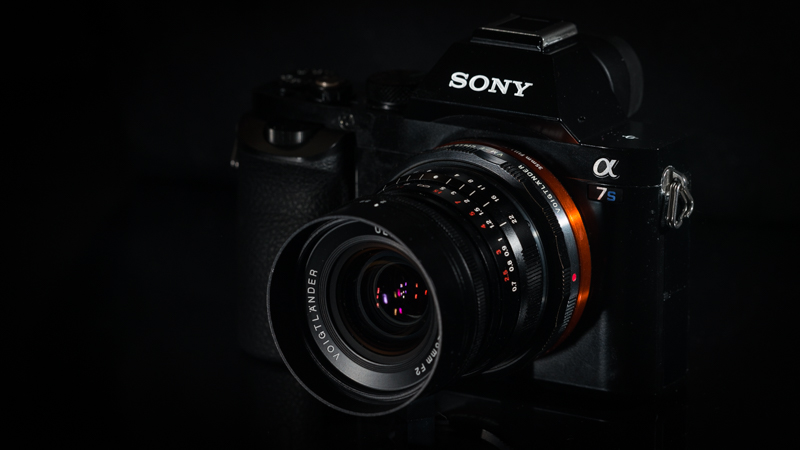
The Voigtländer Ultron 28mm 2.0 is a small wide angle lens with Leica M mount. The lens is features a modern design and has been introduced around 2012, but has already been replaced in 2021 with an updated version reviewed here.
Last update: February 2023
Sample Images



Contents
Specifications/Version History
There have already been 3 versions of the Voigtländer 28mm 2.0 M-mount lens, 4 if we add the earlier 28mm 1.9 M39 lens:
- Voigtlander 28mm 1.9 Ultron
261g (black and silver), 9/7 design, 46 mm filter thread, MFD 0.7 m, M39 - Voigtlander VM 28mm 2.0 Ultron
238g (black), 10/8 design, 46 mm filter thread, MFD 0.7 m, M-mount - Voigtlander VM 28mm 2.0 Ultron Type I
188g (black), 10/7 design, 39 mm filter thread, MFD 0.5 m, M-mount - Voigtlander VM 28mm 2.0 Ultron Type II
230g (black/silver), 10/7 design, 39 mm filter thread, MFD 0.5 m, M-mount
Type I and Type II apparently share the same optics, only the casing design is different. The Type II versions feature a bigger focus tab whereas Type I only features a tiny focus lever. So pick your favorite based on looks and feel.
This is a review of the original Voigtlander VM 28mm 2.0 Ultron (the second entry from the list above).
You can get this lens on ebay.com | ebay.de (affiliate links) for 400$ (used)
The A7 series and Leica-M wide angle lenses

Most of you have probably heard of problems when using rangefinder (which mostly means Leica M mount or Leica M39 thread mount) wide angle lenses on the Sony A7 series cameras. What some might not know: there are huge differences between the different A7 cameras, or, to be precise, between the different sensors in the A7 cameras.
But let’s first recap, which problems might occur:
- color cast on the edges and in the corners
- strong vignetting
- “corner smearing”
Color cast and vignetting are mainly influenced by the sensor design. The A7r is the worst, A7s(II) and A7rII fair much better. One also has to take into consideration that symmetrical wide angle lenses have quite strong vignetting by design and, in this regard, are no comparison to the retro focus designs which are mainly used in SLR wide angle lenses.
The corner smearing on the other hand happens mainly due to the thick (in comparison to the Leica M cameras and especially film, where there is none) filter stack in front of the sensor. The glass is so thick that – in conjunction with the very steep light incidence – it affects the light rays hitting the sensor. In my experience the difference between all the A7 cameras is negligible here. There is one solution though, you may send your camera to Kolari Vision and they will replace the filter stack for you. I have not yet any experience with this replacement, because for people who do not live in the US the whole replacement procedure is a customs nightmare.
There is also a reason I don’t like the term “corner smearing” : what actually happens with many lenses (and I will show that in the performance section) is that the corners are just in a different plane of focus than the center portion of the frame and naturally this problem goes away when stopping down.
This whole topic is discussed in great detail in this article.
Sharpness
infinity
As already mentioned in the second section the lens exhibits significant field curvature due to the thick filter stack of the a7. Depending on the focusing-distance you set even the extreme corners near infinity look quite alright from f/2, but the center will be out of focus in this case.
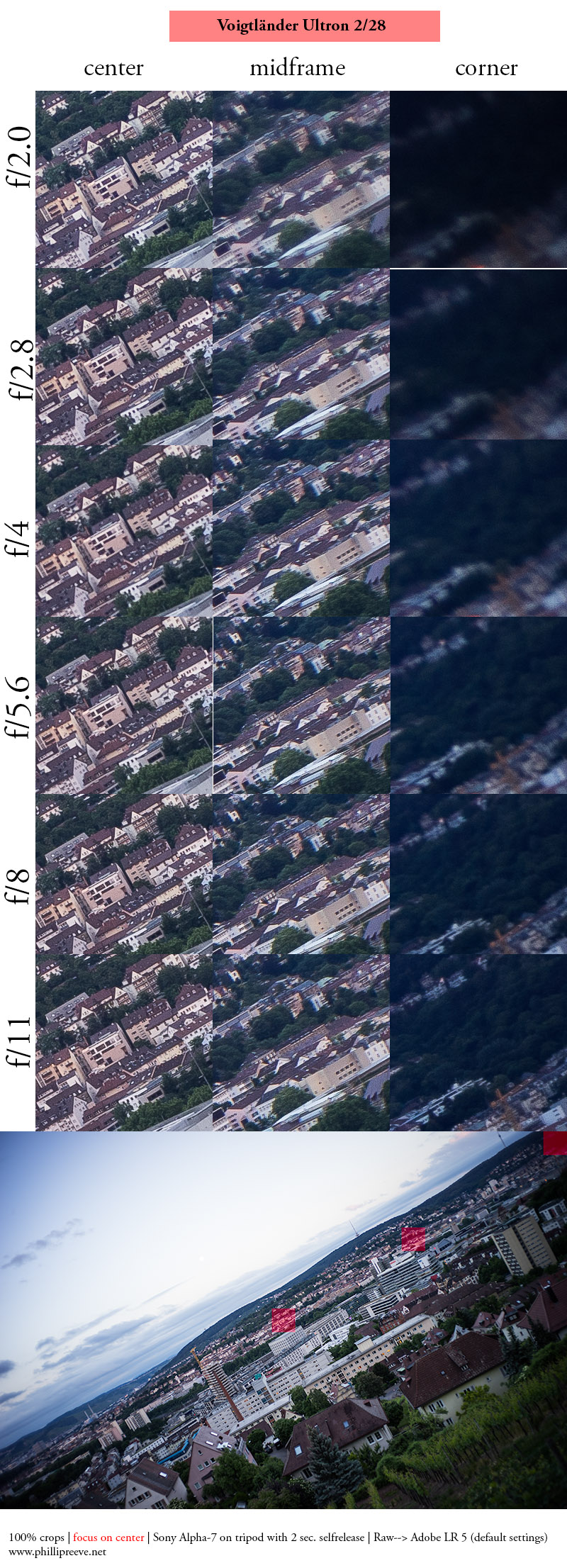
When setting the focus for a sharp center at infinity you will notice awful corner sharpness, even though the center looks really good from f/2.0.
The good news here is: if you have a flat target and focus at the extreme corner the overall sharpness of the frame will suffice even at f/5.6. At f/11 you can just hit the infinity stop and “be there” in the center as well as the corners.
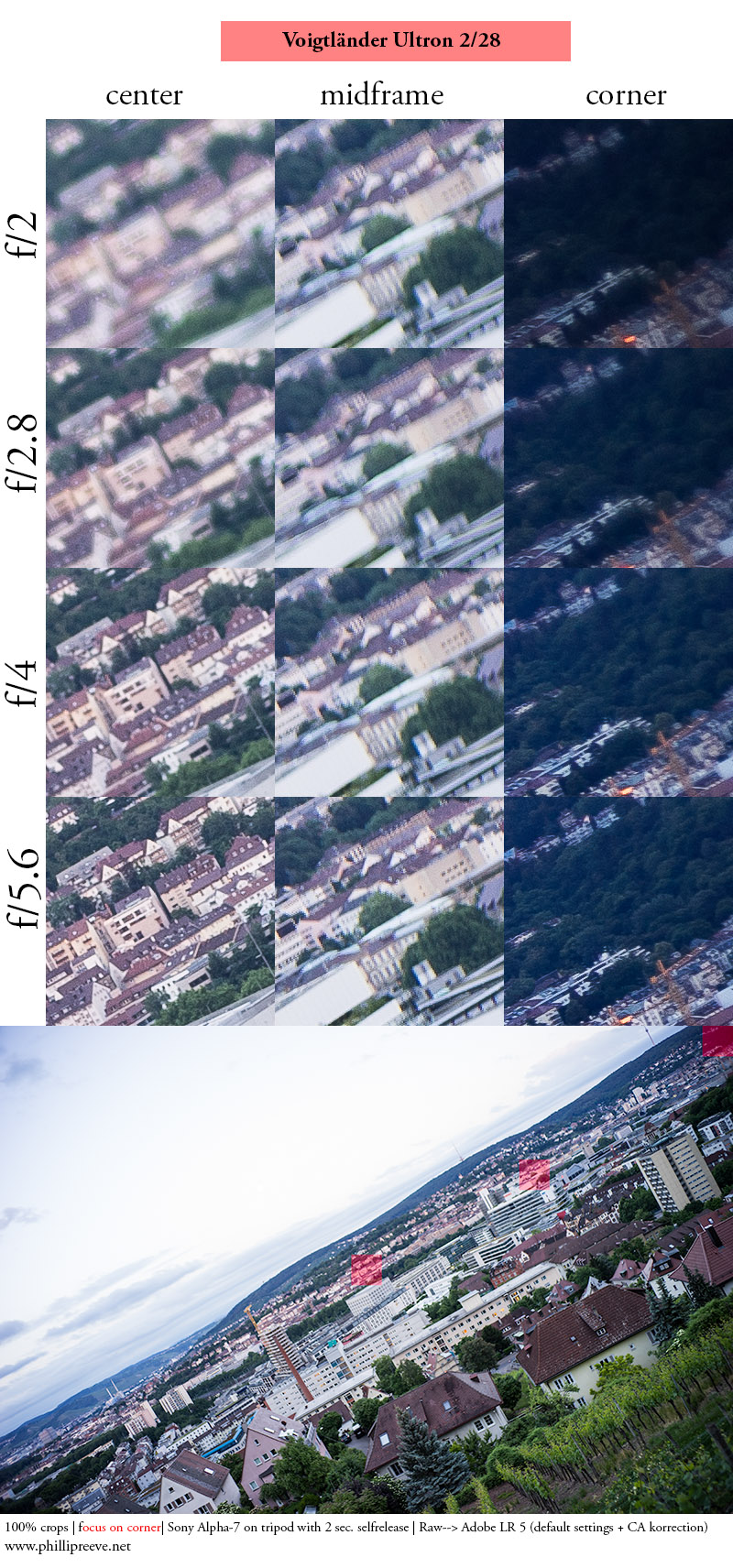
In case your asking yourself how this translates into real world images take a look at the following example:
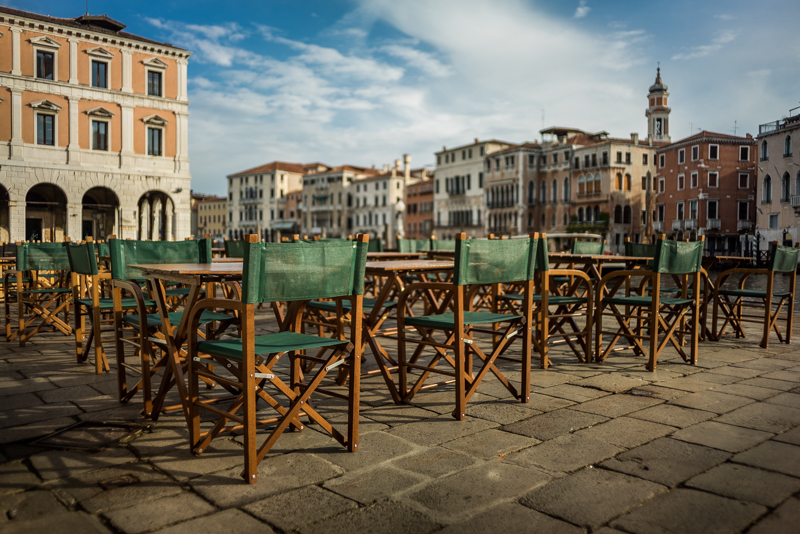
It was shot at f2.0 and focus is on the chair in the foreground. So what you now may notice: the center part of the frame is quite out of focus whilst the edges, not so much.
A common issue when using fast wide angle lenses on fullframe Sony E-mount cameras.
Close focus distance
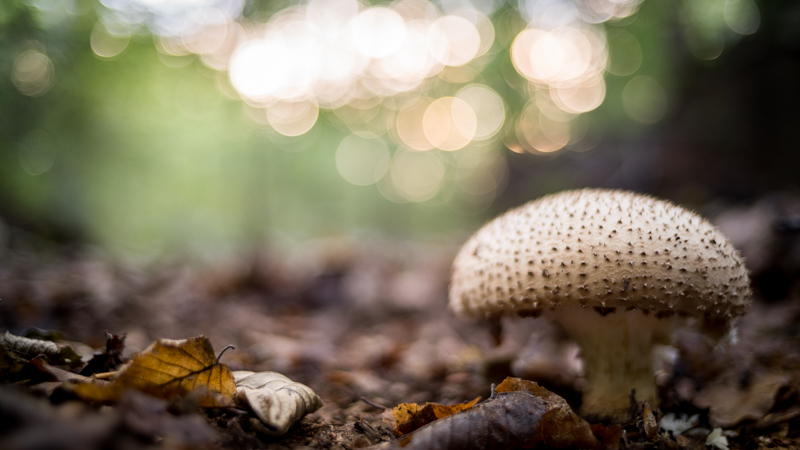
This lens has no floating elements (also often referred to as CRC = close range correction) design which shows, when pushing a bit too far in the macro range with the use of a helicoid adapter. The maximum magnification when using a close focus adapter is 1:5.5. Without such an adapter the minimum focus distance is 70 cm – common for lenses with rangefinder coupling – and therefore the maximum magnification is nothing to write home about here.
Bokeh
In general the bokeh is very smooth, especially for a wide angle lens. Getting close helps of course:
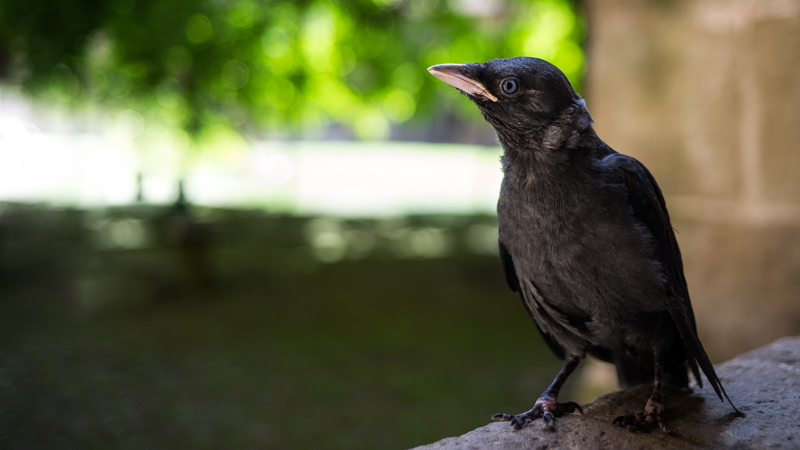
But keep in mind: with 10 straight aperture-blades out-of-focus highlights become ten-sided figures instead of circles on stopping down:
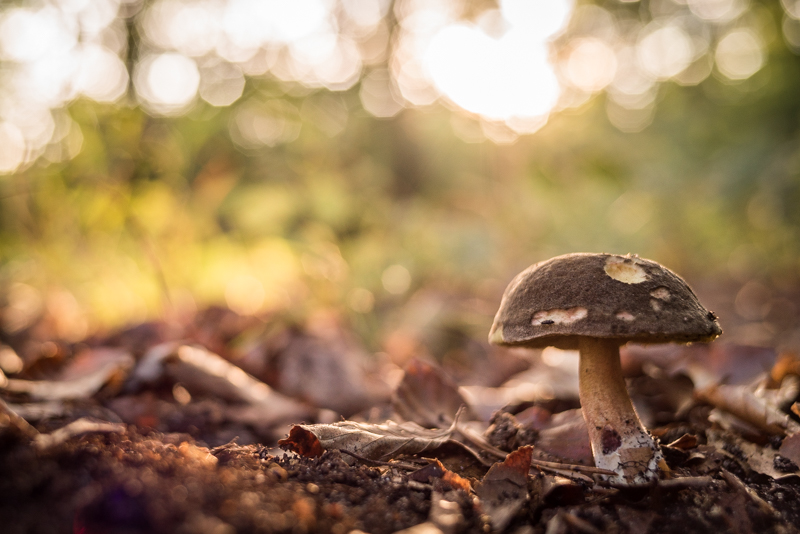
Flare resistance
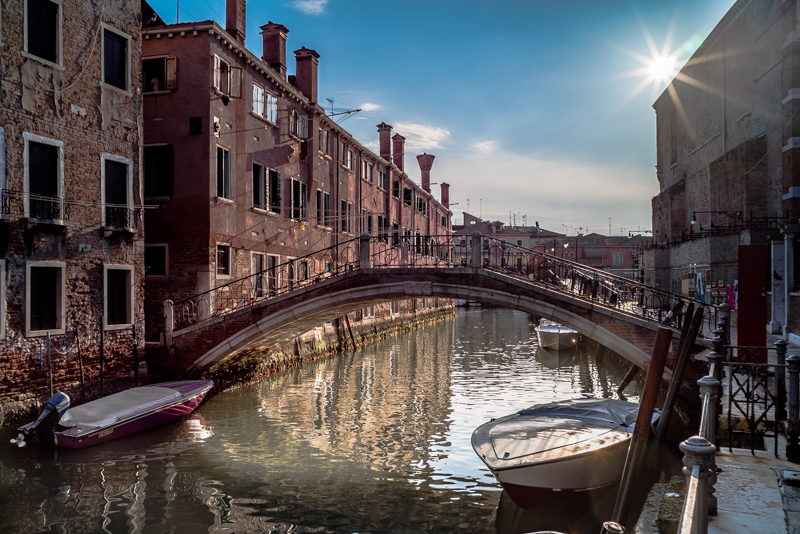
Under certain circumstances you may catch some ghosting and you might see a small loss of contrast but very often I could just shoot directly into the sun without any problems. As with many lenses it really depends on the angle between the lens and the sun.
Sunstars
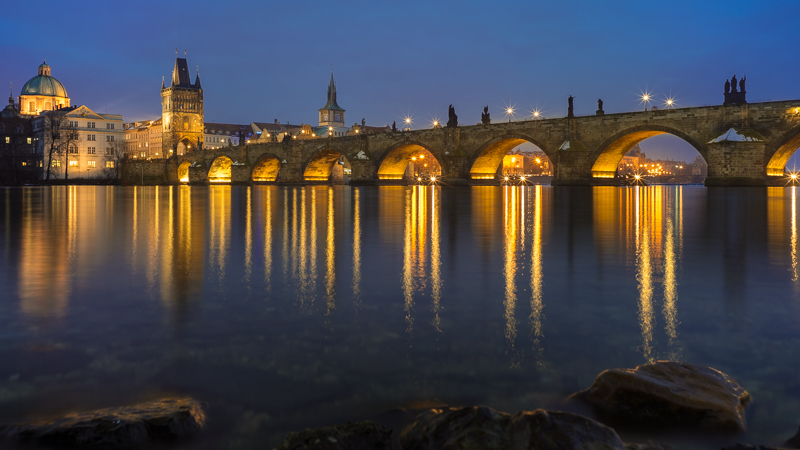
Definitely one of the strengths of the Voigtländer, as it produces wonderfully defined 10-pointed sunstars.
If you want to learn more about this topic have a look at this article.
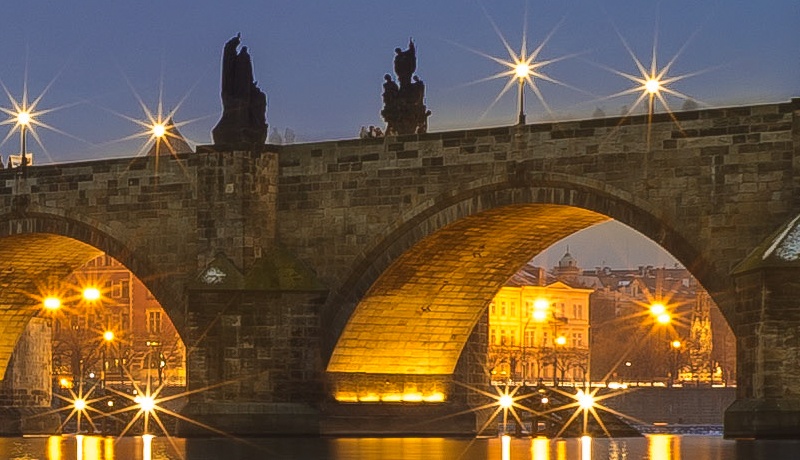
Chromatic aberrations
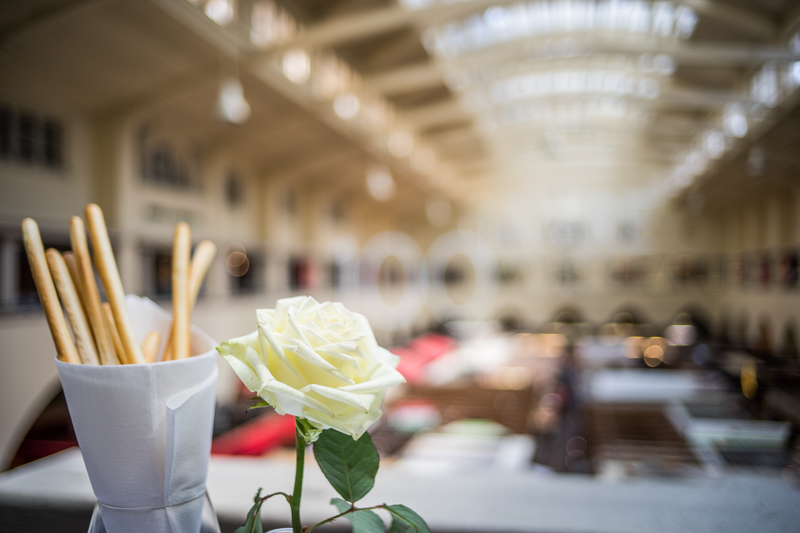
Neither transversal nor longitudinal chromatic aberrations are worth talking about with this lens. This is really good news, especially for the background bokeh. Other lenses often suffer from green highlights around the points of light in case of bad loCA correction, the Sony FE 2/28 is an example for that.
Alternatives
M-mount:
The newer versions offer better performance while being smaller/lighter and they even focus closer. So unless you find a really good deal on this older lens or your greatly prefer its design it is probably a better idea to get one of the newer ones.
For the same money you can also get the one stop faster 7Artisans 28mm 1.4, a real bargain considering its specifications and the few potential competitors.
E-mount:
Best have a look at our Guide to 20-28mm wide angle lenses that covers all the obvious alternatives.
Conclusion
M-mount user:
The Voigtländer VM 28mm 2.0 Ultron is a lens that generally fits the M-system very well: it is compact, lightweight and not too fast – so encountering rangefinder calibration issues should not be the norm.
Thanks to its high resolution, contrast and flare resistance as well as low distortion this 28mm is a great choice for landscape or architecture shooting and due to its f/2.0 maximum aperture it can also be used indoors or during blue hour without a tripod if needed.
If you are mainly interested in shallow depth of field photography I would rather recommend the 7Artisans 28mm 1.4 or one of the faster 35mm M-mount lenses though.
This lens’ strongest competitor is the improved newer version though, especially the improved minimum focus distance of 0.5 m but also it being smaller and lighter would make this the better choice for me.
E-mount user:
The Voigtländer VM 28mm 2.0 Ultron cannot show its full potential on the thicker Sony sensor stack. While the performance is impressive at f/2.0 on the Leica there are some limitations here: if you are shooting at infinity the corners need stopping down a lot to show a comparably good performance and there is also a negative influence on the bokeh rendering, especially at longer distances.
It is still possible you will be happy using this lens on a Sony camera, especially as apart from the – already much bigger and heavier – 7Artisans 28mm 1.4 FE+ there are no manual focus alternatives for FE cameras available.
You can get this lens on ebay.com | ebay.de (affiliate links) for 400$ (used)
Sample Images
I have set up a flickr album which contains many shots taken with the 28mm 2.0 Ultron.
Further Reading
- All M-mount reviews
- Lens aberrations explained
- Review: Techart LM-EA9 Leica-M -> Sony-E Autofocus Adapter
- Review: Mr. Ding 50mm 1.1 M
Support Us
Did you find this article useful or just liked reading it? Treat us to a coffee!
![]()
![]()
![]() via Paypal
via Paypal
This site contains affiliate links. If you make a purchase using any of the links marked as affiliate links, I may receive a small commission at no additional cost to you. This helps support the creation of future content.
Latest posts by BastianK (see all)
- Review: Canon EF 50mm 1.0 L USM – Still the world’s fastest AF lens - December 30, 2025
- Review: Nikon Nikkor 105mm 1.8 Ai-s - December 28, 2025
- 2025 – Year in Review - December 23, 2025
Hi Bastian,
thx for reviewing the lens. My favorite manual lenses are the Voigtländer (Pancake) SL lenses for Nikon. I also had the 28mm SL II F2.8, but it stayed at home, since 28mm is not my focal length, good to see that 28mm can produce nice pictures (these days I enjoy 40-60mm) .
Also I enjoyed the testshots showing Stuttgart instead of Bielefeld (-: !
Drink & Click On !
Nice review. This lens seems to have much in common with the Carl Zeiss 28mm F/2 Distagon, which I use on my Sony A7 with the Nikon F to Sony E mount adapter. Both have a pronounced field curvature (that’s a good thing for my use, not so good for others), both are made of metal and have good flare resistance. Voigtlander seems smaller, lighter and cheaper and of course useable on Leicas. The Zeiss to me produces unique and attractive rendering to images on the Sony A7, with excellent 3D microcontrast and sharpness, especially close up with its floating elements design. Either way, both lenses look to be absolute winners!
Hi SpaceMan,
i have recently aquired the Contax 28mm f/2 “Hollywood” (AEG). This lens is closely relative to your Distagon 28mm f/2 ZF, its ancestor.
To be honest, i don’t think that the Distagon and the Ultron have much in common. I see a very strong midzone-dip here in the Ultron aperture series (even at f/5.6) that the Distagon only has until f/2.8. At f/5.6, it is very sharp all over the frame, even with the more demanding A7R. Field curvature for the Distagon is surprisingly low, actually it is possible to get a corner-to-corner landscape shot at f/2 although there is a lot of astigmatism in the corners wide open.
If size, weight and cost don’t bother you, the Distagon could be the better choice.
The Ultron could be attractive if you like the special character of the lens, that Basti worked out very good here.
I think, that I am going to review the Distagon 2/28 later this year.
Will we get a review of the Contax 28mm f/2 anytime?
As Jannik wrote above: near the end of the year 🙂
Thanks for this review, it has good information 🙂 I like to see a review of the Minolta 28mm f/2.8 Rokkor-M for Leica mount is small too and is not to expensive
Dear Jorge, I will first review the Leica M lenses I personally own, because unfortunately even the “cheap” ones are too expensive to just buy them for the purpose of writing a review 🙂
I live in Germany and I own a mint Rokkor-M 28 f2,8 – you could borrow it from me 😉
Thanks a lot for this review. Just received a Rokkor 28mm f/2 (113€ on ebay) and am waiting for the Zhongyi ii focal reducer for my A 6000 (would alledgedly give a 30mm f1.4 eq FF).
First shots show nice bokey at f2.0 (but it clearly depends on subject).
I saw you reviewed it. How does it compare to the Sony and the Voigtlander?
Hey, I did not yet have a chance to try out the Rokkor 28mm 2.0, but for that price you paid you can’t go wrong I guess 🙂
The 28 f2 CVC is one of my favorites as well primarily for its contrast and color. The focus issue is really nonexistent on APSC.
Hi,
I just dropped my voigtlander vm 28mm f2 ultron and damaged the lens hood. I can’t seem to find a replacement for this lens. Do any of you know of any compatible hood with the lens, attachable to the female thread it has and not to the inner 46mm filter thread ?
I don’t think there is another option but the original hood.
Did you try contacting Voigtlander directly?
Hey,
whats your suggestion for a good adapter lm-nex for the ultrons 28 and 35 regarding
1 infinity stop?
2 possible frontfilter fix?
your input is very much appreciated.
(with my minolta lenses i always used a novoflex adapter. might that be to precise for having enough space for point 1 and 2?)
I just bought this one and it works with the CV35 and a 5m lens: http://amzn.to/2nbBrEI
I don’t know of any tests with the 28, if it requires a stronger correction lens it might not reach infinity with the K&F. There is also no guarantee that another K&F adapter will be just as thin as mine and there seems to be some variation of the flange focal distance of Sony E-mount cameras.
Hello,
I’m A7 user, and i’m thinking to buy one of this lenses:
Voigtlander 28 F2 or the FE 28mm F2, or Nikkor 35mm F2 or per finish the Zeiss Flektogon 35mm f2.4.
Can you say me what is your preference in this case?
Thank’s
Best regards.
These are all very different lenses.
I have never used the Zeiss Flektogon 35mm 2.4.
The Nikkor 35mm 2.0 has what I would call mediocre to bad bokeh and is quite big with adapter.
When it comes to VM 28mm 2.0 and FE 28mm 2.0 the question is:
Do you need/want AF, what sunstar rendering do you prefer, would you rather have the solid housing of the VM or the lightweight of the FE?
I can’t answer these questions for you.
Thank’s bastian.
Good to know that Nikko 35 is not good.
So, now i’m looking two Voigtlander, the 28 F2 and the 35 F1.7 more the Sony 28 F2.
About the weight or the AF i do not have preferences, what I want is a lens between 28 and 35 with a beautiful bokeh and with good image quality.
First, sorry for my bad English. I’m a “newbie” in photography but I was really interested in your review on this beautiful lens. But I don’t really understand the field curvature part, can you make a more detailed explanation about this problematic issue ? As far as I understand, field curvature is the DOF being curved so when I want my camera focus on the center of a plane which is perpendicular to camera’s direction, the corner of the plane will be out of focus or otherwise, is it right ?
You can have a look at this article where the whole topic is discussed in detail.
Have you ever tried a front filter on this lens?
We haven’t but others have: http://www.fredmiranda.com/forum/topic/1512393
Hi Bastian, what about the incredible manual Nikon 28/2.8 AIS with 8 elements, one of the most perfect lenses at the time..did you try this one, too?
So far I did not, but I also heard many good things about it.
Bastian and Philip,
How does the 28mm Ultron compare to the 35mm Ultron in terms of bokeh, IQ at portrait distances, and vignetting? I read your review of the 35mm Ultron and 35mm “shoot out” as well. I would use either one on a Sony A7r3.
I don’t mind the difference in focal length, but am more concerned about the aforementioned issues.
Thanks!
There is not that much difference in image quality as well.
If you do not intend to use a helicoid adapter the 35mm 1.7 might be the better choice though as it focuses down to 0.5m (28 only to 0.7m).
Thanks Bastian for the advice! I always enjoy the articles here. The 28mm is a couple hundred dollars less than the 35mm Ultron, so their similar image quality is positive for me as a user.
I am very new to photography, I have the Sony 55 and 85 plus the Tamron 28-75, of the Ultrons would you recommend the 28mm or 35mm for indoor family candids (in home and hotels) and some vacation environ portraits?
Thanks again!
As it is faster and longer at the same time I would get the 35mm 1.7 for that purpose.
Here are some samples for that application:
https://www.flickr.com/photos/bastian_k/35573048700
https://www.flickr.com/photos/bastian_k/37286348471
https://www.flickr.com/photos/bastian_k/34854390274
https://www.flickr.com/photos/bastian_k/34142994245
Bastian
Once again, thanks for the response and the great advice! Awesome photos too, love the shot of the lady facing the alpine lake. I’m on the hunt for a 35mm Ultron now.
Happy to help 🙂
Hi Bastian, the new version of Ultron 28 seems really promising. Do you have plans of reviewing it as well?
Due to Brexit it is harder for us to get Voigtländer review samples at the moment.
If someone offers me one I will review it, but it may take a while.
There is now an Ultron II aspherical. It is tiny and optically excellent. For me it is better than all the 28mm lenses you test here. Maybe you should have a look.